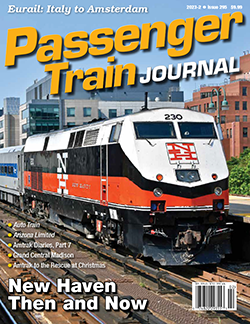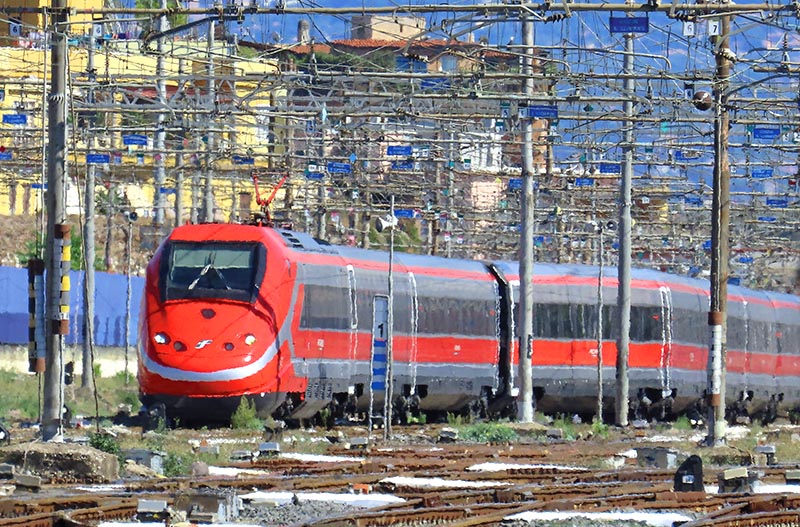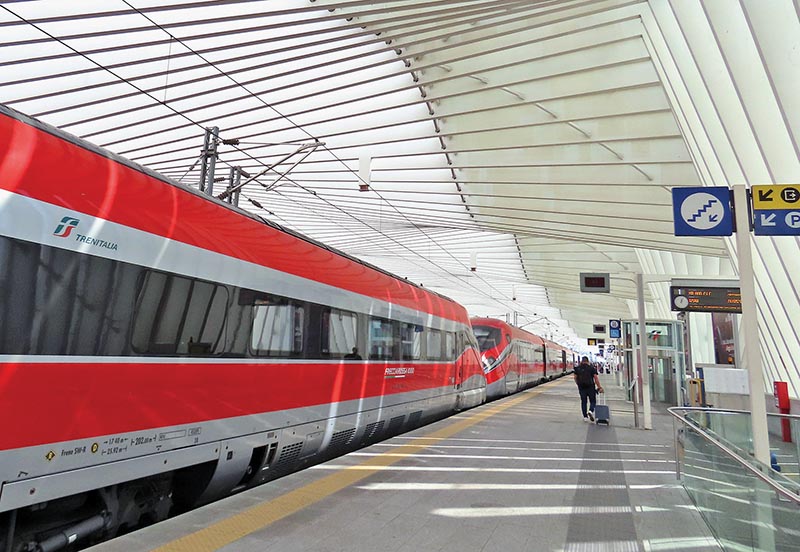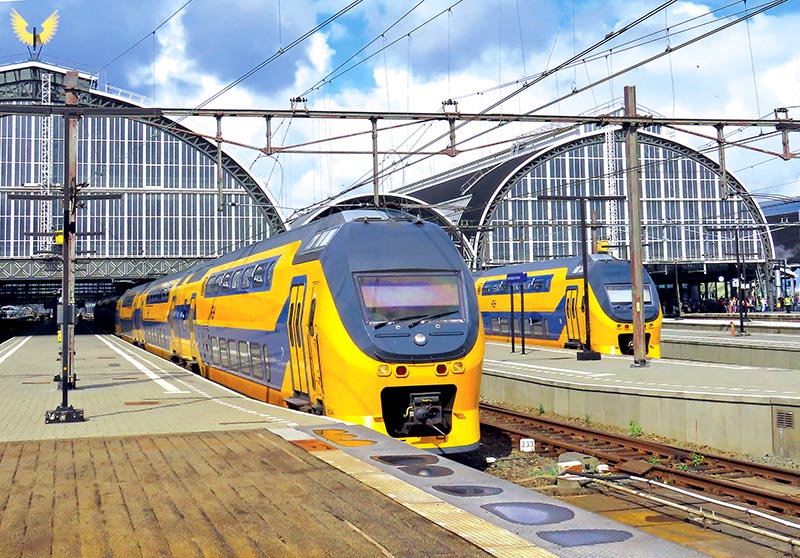 by Kent Patterson/photos by the author
by Kent Patterson/photos by the author
I’m confident when navigating Amtrak, but fear overwhelmed me when I was invited to a wedding in Italy in late 2022. Having been ensconced in North America since 2000, the pandemic and an ever-changing travel environment intimidated me greatly. Months prior to departure, I had my passport, flight reservations with ITA (the reorganized successor to Alitalia), had booked a Hilton Garden Inn room in Rome, and had bought a five-day Eurailpass (taking advantage of discounts by purchasing it before leaving North America). After procuring those basics, planning began.
Paper schedules, annoyingly, had largely disappeared, superseded by slower schedule apps, which have a reputation for being cumbersome. A paper Eurail map was purchased; it was a small-print European Rail Timetable, akin to the old Cook’s Continental Timetable — an Official Guide of sorts — and helped initially to familiarize me with routes and plan the journey. With the maps, I got more comfortable planning with the schedule app. Soon, the timetable became less essential and I ended up not taking it with me to Europe. Online schedules worked decently with maps, with planning eased thanks to Europe’s tendency to employ user-friendly memory-patterned schedules. National operators strive toward services that operate once every hour or two, and this patterning is even found on rural branches. Busier corridors may have up to four departures per hour, at varying service levels from high-speed trains (HST) down to connection-intensive locals. The European passenger-rail network is tightly meshed, like an urban transit system but continental in scope. Those patterned schedules tend to foster connections of an hour or less. (This also means you should pay close attention to departure boards when transferring.) Frequent trains on many routes help mitigate any missed connections.

ABOVE: A Trenitalia Frecciarossa high-speed train navigates the approach to Rome Termini station.
Opting not to make online reservations, instead I chanced same-day reservations made in person at ticket offices, usually early in the day. English-speaking agents are usually available. Traveling in the early off-season, and at mid-week, helped avoid crowded trains. Eurail’s free, full-featured Rail Planner smartphone app identifies when seat reservations are needed, and can help passengers avoid full trains.
Italy
Rome was to be the starting point for my rail trek, traveling north through Switzerland, France, Luxembourg, and finally to Amsterdam in the Netherlands, using a variety of day trains.
Emerging from the older Italian State Railways, Trenitalia operates a spectrum of services from utilitarian to posh, covering 15,000 miles. Trenitalia’s basic services are unreserved Regionales, akin to commuter services. A slight enhancement is Regionale Veloce, which are faster commuter-type trains over longer distances. The third, which I didn’t sample in Italy, are branded as Intercity trains. They often have two-class service, usually no café, and still are often made up of locomotive-hauled coaches, now be-coming a rare sight elsewhere.
Complementing that national net-work of workhorse trains are Trenitalia’s three glamorous high-speed services. Top of the line is Frecciarossa (in English, “Red Arrow”). This premier product keeps to dedicated rights-of-way, making it Trenitalia’s fastest service tier.

ABOVE: The top tier of Italy’s three HST brands is Frecciarossa, with this example seen at a regional station south of Milan on September 5, 2022, on Rome-Milan train FR9520. Paired consists, coupled nose to nose, are a common sight. Trenitalia currently operates 50 of these Alstom/Hitachi ETR1000 trainsets.
The second tier in Trenitalia’s high-speed product line is Frecciargento (Silver Arrow ), relying on former TGV equipment. Its role is serving cities not yet provided with true high-speed service. These trains travel at up to 150 mph over HSR portions, and adhere to local speeds when not in HSR territory. Often they still run at 100-120 mph over remaining non-HSR regions. As more HSR routes are completed, the second-tier Frecciargento service will be dissolved.
A third, more basic, HST product is Frecciabianca (White Arrow ). These simply maximize the 100-120 mph capabilities on secondary main lines by making few stops. Speeds are somewhat similar to the faster emerging North American higher-speed lines.
Onward from Rome
My first train was a 10:12 a.m. Regionale Veloce, RV4128, from Rome to Pisa. Other rail options were hourly Regionales (locals with a transfer), Intercity trains, and some high-speed Frecciabiancas on this secondary main line. I took the unreserved train, which had ample seats.
We passed coastal Mediterranean resorts and saw exotic birds as we made our 220-mile run to Pisa-Centrale in a respectable four hours. While not advertised for speed, between stops our EMU train easily surpassed 100 mph. Regional passenger trains routinely reach that speed in Europe where distance and terrain allow.
The next day’s journey was to Zurich via Milan. I departed Pisa Centrale’s small city station en route to Florence for a reserved connection to the premium high-speed Frecciarossa. Armed with pastry and coffee from the newsstand/buffet, I rode inland on a final Regional Veloce, joining Italy’s high-speed main in Florence, Tuscany’s capital. The 60-mile line upgrade is served mainly by regional trains, yet makes the run with six stops in an hour. Riding region-al trains worked well; no reservations needed, decent seats, air conditioning, and adequate speed. By now, though, I was hungering for Italy’s high-speed line. For me, Italian HSR has a certain mystique. Italy started tinkering with fast electrified trains on the Rome–Florence (Firenze) corridor in the 1930s.
Italy’s principal HSR main line spans 580 miles from Salerno in the south, northwesterly to Naples, Rome, Florence, Bologna, Milan, and finally Torino, near the French border. The original two-track main line continues carrying regu-lar passenger service, and some freight. More HSR lines are under construction…



